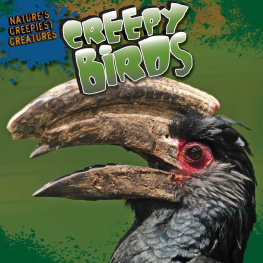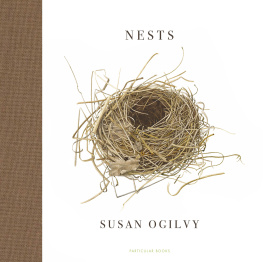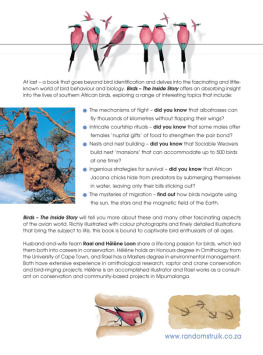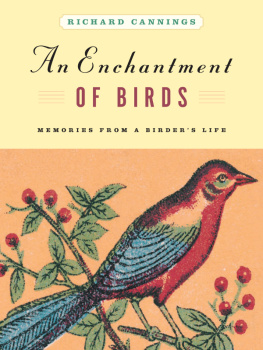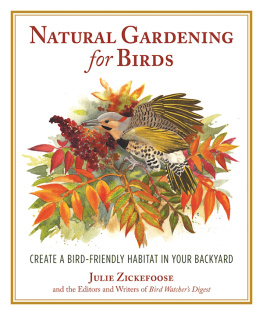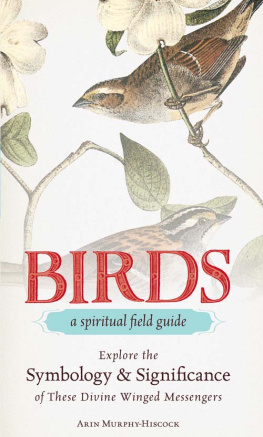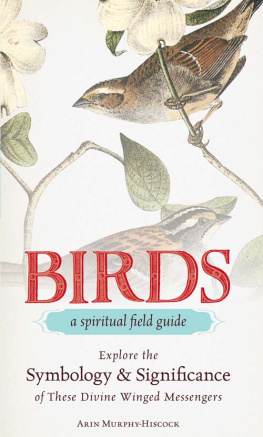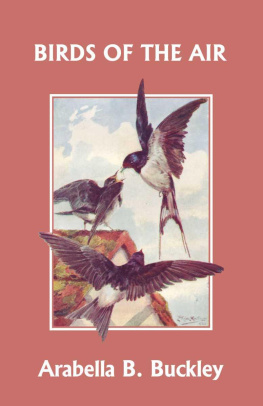

FIFTY NESTS AND THE BIRDS THAT BUILT THEM
BY SHARON BEALS
Introduction by SCOTT WEIDENSAUL
Foreword by JACK DUMBACHER and MAUREEN FLANNERY
Illustrations by LAURIE WIGHAM

Text and photographs copyright 2011 by SHARON BEALS.
Introduction copyright 2011 by SCOTT WEIDENSAUL.
Foreword copyright 2011 by JACK DUMBACHER and MAUREEN FLANNERY.
Illustrations copyright 2011 by LAURIE WIGHAM.
Poem on 2008 by MIMI WHITE, from The Last Island , Deerbrook Editions, 2008
All rights reserved. No part of this book may be reproduced in any form without written permission from the publisher.
Library of Congress Cataloging-in-Publication Data available.
ISBN: 978-1-4521-2665-4
Design by SARAH PULVER
Chronicle Books LLC
680 Second Street
San Francisco, CA 94107
www.chroniclebooks.com
FIELD NOTES
I watched a bird
Flitting upside down
On the gray sky.
She was small as a thumb,
Striped with rust
And speckled rose.
I had thought to name her,
To locate her genus
In a color-plated guide.
The bird was neither
A robin nor a thrush,
But what stills my mind
Is what I know:
A pocket of feathers,
An assemblage of song,
And when there is no love
Left to extinguish,
The sky.
MIMI WHITE, The Last Island
INTRODUCTION
Scott Weidensaul
WHEN I WAS A CHILD, MY MOTHER HAD LONG BLONDE hair that fell well below her waist. In spring and summer, she would carefully brush it out while sitting on the back porch shortly after daybreak, surrounded by birdsong; after cleaning the brush, shed place the handful of pale, yard-long hairs in a rosebush that climbed a trellis by the steps.
Later, when I began poking into the lives of the local birds, I found that in our neighborhood almost every Chipping Sparrowa species that for much of Americas history lined its nests with horsehairwas laying its eggs in a neatly woven cup of gold, courtesy of my mother.
My fascination with birds nests has never waned. From poking into robins nests and watching swallows roll small pills of mud to carry to the rafters of a friends old barn, I graduated to spying on the Broad-winged Hawks that raised their chicks on the mountain behind our home, to shinnying up into a Great Horned Owl nest, to passing hours observing a female Baltimore Oriole weave endless strips of tough milkweed fibers into a miraculous purse that hung safely over my favorite trout stream.
I loved the way I could stand on a breezy hillside in early spring, raise a handful of large, fluffy feathers, and have a mob of Tree Swallows swarm me in frantic competition for the white treasuresdiving, swooping, squeaking angrily at one another, until the victor carried off the prize. And I lovedI still lovegently opening the lids of my nest boxes, to see those same feathers arranged like cupped hands, cradling a clutch of small, white eggs.
In the pictograms made by the human brain, the phrase birds nest conjures up a simple, tidy grass cup, but the reality is wildly more diversethe two-ton, Volkswagen-sized nest of a pair of Bald Eagles, accumulated through the generations until too heavy for its own tree; the messy jumble of a Cactus Wren nest, impregnable within the arms of a cholla; the musty-smelling burrows of storm petrels on Maine islands; Burrowing Owls in old prairie dog dens; kingfishers and Bank Swallows digging into riverside embankmentsto say nothing of the room-sized colonies of some African weaver finches, or the mud-daubed apartment complexes of Cliff Swallows, teeming bird cities thousands of tenants strong.
Oddest and most wonderful of all, there is the Edible-nest Swiftlet, with its translucent, half-circle nest glued to the side of an Indonesian cave, composed of nothing but the dried strands of the birds own glutinous saliva, painstakingly laid down, bit by bit, for more than a month.
Nor is the Swiftlet the only species for which nest building is sheer labor. I once watched a female Black-chinned Hummingbird carry long, almost invisible strands of spider silk through the air, catching the loose end on a branch, then looping it around and aroundrepeating the process as she slowly built up a sticky pad on which the real work of nest construction would commence. By the time she was finished, two weeks later, she would have assembled uncounted miles of spiders webbing to make her walnut-sized nest.
And because nest-building is a purely instinctive process, I also catch my breath at the marvel of a bird, using no blueprint but one mapped out behaviorally in its genes, assembling the trim elegance of a vireo nest, framed between a slender, forked branch, its construction ever more refined from outer wall to the grass-lined inner cup, or the little flourishes some species invariably add, like the dangling strings of old grapevine bark and grass beneath an Acadian Flycatchers nest, which make it look like an innocent bit of trash. No eggs here, it seems to say to a sharp-eyed predator; just keep moving.
Those Broad-winged Hawks I watched as a boy often brought leafy branches of black cherry to the nest; I now know that as the leaves wilt, they release gaseous cyanide, a natural pesticide. Yet even that is not the most remarkable example of housekeeping among birds. Eastern Screech Owls, whose chicks made a noisome, gooey mess in their tree cavity home, will capture and bring back alive small blind snakes, which burrow into the felted mass of old prey remains and whitewash, and eat the blowfly larvae and other harmful insects that live there.
My childhood love of nests has only deepened with time and travel, both of which have given me the chance to see a range of bird nests on far-flung and exotic places. Ive found the nests of tropical hummingbirds glued to the undersides of wide heliconia leaves, a natural umbrella in the rain forest, and seen colonies of oropendolascrow-sized relatives of our orioleswith pendulous, four-foot-long nests in which you could comfortably rock a human infant. Ive helped biologists ease the newborn chicks of auklets from their burrows in teeming Aleutian colonies; tiptoed among nesting terns on desert islands; and clung to a rope on a foggy, windswept cliff in Newfoundland, hundreds of feet above the churning surf, as Razorbills and murres balanced their eggs on ledges so narrow they would be laughable, were the consequences of a fall not so great.
But perhaps no single birds nest has ever affected me like that of the Bar-tailed Godwita dove-sized shorebird that, in truth, makes almost no nest at all. Some years ago, in the Yukon Delta of western Alaska, I knelt beside such a nest, a depression as big as my fist simply hollowed out of the soggy tundra and meagerly lined with bits of reindeer lichen. Around it, nodding in the breeze, were white salmonberry flowers.
The male godwit, wings flashing and his breast cinnamon colored, flew around me in an angry orbit, peppering me with rapid-fire too-vee, too-vee calls. He and his mate had arrived here only weeks earlier after the last leg of an annual journey that carries them seven thousand miles across the widest part of the Pacific to New Zealand, then northwest to Asia in the spring, and back to Alaska. That immense, eighteen-thousand-mile journey, perhaps the most challenging of any birds and a physical feat incomprehensible to a mere human, had but a single purpose, whose fruit lay before me: four greenish eggs blotched with brown.
Next page

